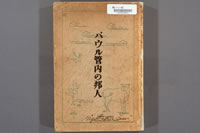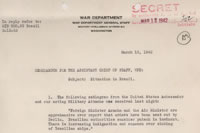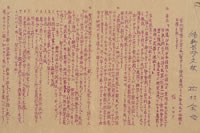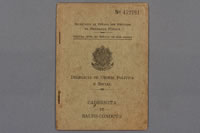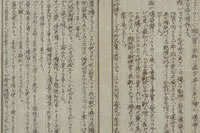Japanese community situations before and after the outbreak of the war between Japan and the U.S.
Advocacy for re-emigration to Asia
Some Japanese immigrants began to advocate re-emigration to Hainan Island after the Japanese Army occupied the island in February 1939. They advocated that Japanese immigrants should leave Brazil which had become more difficult to live in with Japanese exclusion intensified, relocate to an Asian area occupied by the Japanese Military, and take advantage of their experiences about reclamation to become a leader in the area. Afterwards, arguments for re-emigration to Manchuria or Southeast Asia were also enthusiastically adovocated, which made Japanese immigrants wish ferverntly for returning to Japan. There is data which show that in 1938, 85% of the Japanese immigrants who resided in in the areas under the jurisdiction of the Bauru Consulate of Japan in the northwest part of São Paulo wished to return to Japan, and in 1939 the number of Japanese immigrants returning to Japan was 2,011, which exceeded the number (1,546) of new incoming immigrants.
Discontinuation of Japanese language newspapers
With the world war approaching, the conditions facing the Japanese became harsher. In 1939 a compulsory registration of aliens was introduced, and in August 1941, the publication of Japanese language newspapers was banned, which made the amount of information very small to which the Japanese immigrants had access who could not read Portuguese.
With the ship Buenosu Airesu-maru arriving at the port of Santos on August 13, 1941, the emigrant ship service from Japan were discontinued.
Outbreak of the war between Japan and the U.S. and the severing of diplomatic relations
On December 9, shortly after the outbreak of the war between Japan and the U.S., President Getúlio Vargas issued a statement saying, "In regard to the attack against the American continents by Japan, Brazil expresses its solidarity with the United States from a viewpoint of the collective defense of the American continents". As a result, even the pro-Axis newspaper whose views had been favorable to Japan changed their views to anti-Japan views, and various false rumors and propaganda against Japanese were spread, and Bralian people’s feelings towards Japanese people steadily deteriorated.
On January 28, 1942, the Brazilian Government announced the severing of diplomatic ties with the Axis nations, the Japanese embassy and consulates were closed and their contact with Japanese residents was prohibited. Thereafter, the rights and interests of Japanese residents were represented by the Spanish Embassy, and then by the Swedish Embassy after Spain's entry into the war.
Restrictions on the freedom of Axis nationals
The Security Office of São Paulo State issued an ordinance which banned distribution of materials written in a native language of the Axis nations, singing of a national anthem of the Axis nations, conversations in a native language of the Axis nations in public places and discussions on international situations as well as prohibited a gathering of Axis nationals in private homes, and restricted freedom of movement. Japanese were successively detained and arrested by the Brazilian authorities on the grounds of suspicion of espionage or violating the above restrictions based on anonymous and groundless tip-offs from Brazilians.
On March 11, the Decreto-Lei N. 4.166 (Decree-Law N. 4.166, Order on the freezing of assets of the Axis nations) was issued, which required compulsory deposits of a portion of Axis nationals’ bank savings and credits, prohibited disposition of their possessions, and confiscation of properties of public corporations and residents overseas of the Axis nations to be allocated to compensation of war damages caused by them. On July 3, the Japanese diplomatic corps returned to Japan on board the exchange ship. Immigrants felt themselves treated as abandoned people and left behind
On July 3, the Japanese diplomatic corps returned to Japan on board the exchange ship. The migrants felt themselves treated as abandoned people and left behind.
Internment and deportation
On August 18, a German submarine sank a Brazilian passenger ship in Belem at the mouth of the Amazon River, and many people were killed. Enraged Brazilians rioted and attacked Japanese, German and Italian, Axis nationals. Japanese people in Belem were interned in immigrant internment camps under protection of the authorities, taking with them only the barest of necessities. As mentioned above, the Tome-Acu (Acara) Colony was used as an internment camp for Axis nationals in the northern part of Brazil, and also Japanese people in the Amazon upstream regions were sent there.
On September 6, an order was issued for evacuation of Japanese people from the Conde de Sarzedas (abbreviated to "Rua Conde" or "Conde Street") area in which in São Paulo City a large number of Japanese people had lived.
In March 1943, an order was issued that prohibited Axis nationals from traveling within the country without police permission.
On July 8, a German submarine sank five Brazilian and American cargo ships, and on the same day, all Axis nationals, including Japanese people, were ordered to evacuate the port city of Santos within 24 hours, on the grounds of preventing espionage. Axis nationals were temporarily interned in the Immigrant House in São Paulo City.
In Brazil, although such mandatory evacuations occurred, relocation of people of Japanese descent to internment centers in the United States did not occur as in Peru and other Central and South American Countries.
These controls and regulations of Axis nationals continued until they were relaxed and cancelled with Germany's surrender on May 7, 1945. (Brazil's entry into the war with Japan was on June 6 thereafter).
Sabotage of mint production and silk farming
During the war Japanese farmers engaged in mint production and silk farming were attacked by people of the same descent. Before the war, the United States imported both mint and silk from Japan, but the importation was interrupted by the war. So the United States instead obtained those items from Brazil. As a result, prices jumped suddenly, and Japanese farmers engaged in mint production or silk farming benefited financially. Because mint was used in the manufacture of explosives and silk for making parachutes, however, there were those in the Japanese community who thought the production of these items was an act advantageous to the enemy from around 1943 a group of Japanese calling themselves the "Tenchugumi" (Divine punishment group) and "Seinen Aikoku Undo" (Youth Patriotic Movement) set fire to mint production plants and silk farming sheds of Japanese farmers in outlying areas of São Paulo State.
In February 1944, a retired military officer Junji Kikkawa formed the "Kodosha" to put an end to these "hostile industries" and "unpatriotic actions" and to "lead Japanese people in the right direction". The Kodosha was renamed the Shindo Renmei in May 1945.
-
 Shungoro Wako's "Return to Japan or permanently settle"
Shungoro Wako's "Return to Japan or permanently settle" -
Articles in newspapers / magazines
-
Purchase of yen bills (article published in a Japanese language newspaper)
-
Immigrants’ sentiments for the return of Ambassador, Consuls General and other diplomats to Japan
-
 U.S. War Department Military Intelligence Division information on Japanese secret military organizations
U.S. War Department Military Intelligence Division information on Japanese secret military organizations -
 Documents from the local police department and the Japanese Consulate in São Paulo during the first stage of the war
Documents from the local police department and the Japanese Consulate in São Paulo during the first stage of the war -
 Diaries of Masao Hashiura
Diaries of Masao Hashiura -
 Portuguese language newspaper article reporting the forced evacuation of Axis nationals from Santos
Portuguese language newspaper article reporting the forced evacuation of Axis nationals from Santos -
 Passbook used during the war
Passbook used during the war -
 Document describing that mint was used for military purposes
Document describing that mint was used for military purposes

